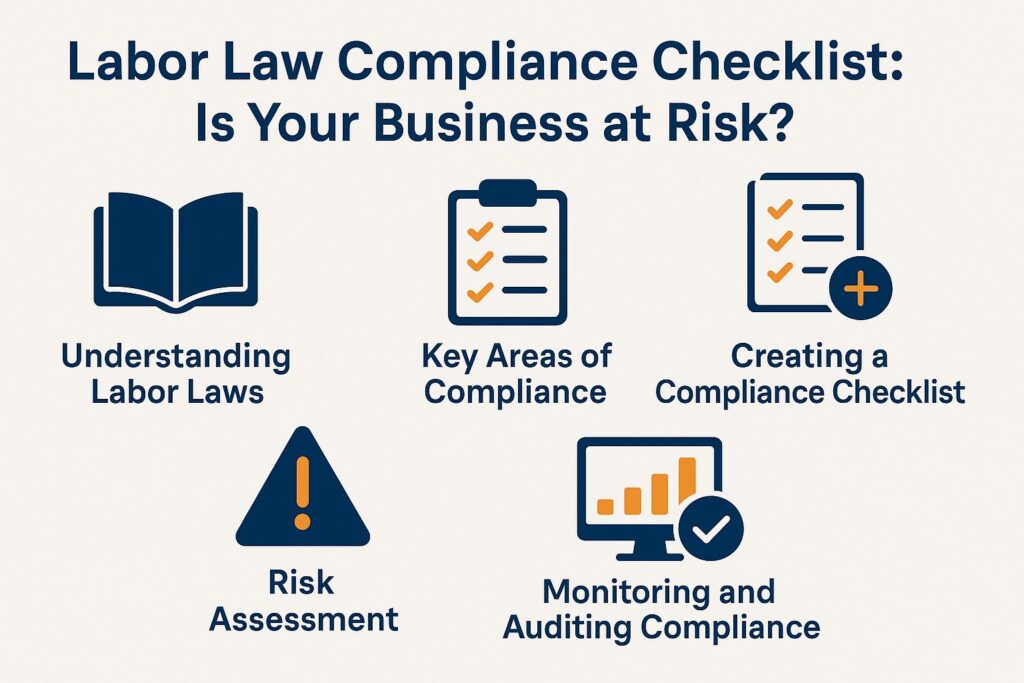
Labor Law Compliance Checklist: Is Your Business at Risk?
Are you confident your business is on solid legal ground? Labor law compliance isn’t just a formality; it’s a lifeline that protects your business from costly penalties. With changing federal, state, and local rules, you might unknowingly be exposed to risk. This checklist will guide you through key areas like wage regulations and employee classification, ensuring you stay ahead of compliance challenges. Let’s dive in and safeguard your business together.
The Importance of Labor Law Compliance
Staying compliant with labor laws protects your business from legal repercussions and promotes employee morale by adhering to workplace policies.
Following labor laws brings many benefits, such as higher employee satisfaction, lower turnover, and improved working conditions.
For example, companies that consistently monitor compliance report a 30% decrease in legal disputes. Regular training on workplace rights and employee training can improve employee morale. Many companies use platforms like TrainHeroic or ComplianceCulture for effective training courses.
Establishing an open-door policy encourages communication about workplace concerns, creating a more positive environment. Businesses that prioritize compliance and follow best practices also benefit from improved overall performance, as happy employees contribute more actively to company goals.
Overview of Labor Laws and Regulations
Labor laws encompass a wide range of regulations that govern employee rights and employer responsibilities, including wage laws, hiring practices, and anti-discrimination policies.
In the U.S., key labor laws include the Fair Labor Standards Act (FLSA), which sets minimum wage and overtime requirements, and Title VII of the Civil Rights Act, prohibiting workplace discrimination based on race, color, religion, sex, or national origin.
States often expand on these protections, enacting laws that may increase minimum wage levels or offer additional employee rights. Local governments may further tailor regulations, perhaps requiring paid sick leave or other benefits.
Knowing these layers is important for following the rules, encouraging fair practices in the workplace, and ensuring legal compliance. Worth exploring: how a PEO can protect businesses from potential lawsuits related to labor compliance.
Understanding Labor Laws
Knowing the different levels of labor laws-federal, state, and local-is essential for full compliance.
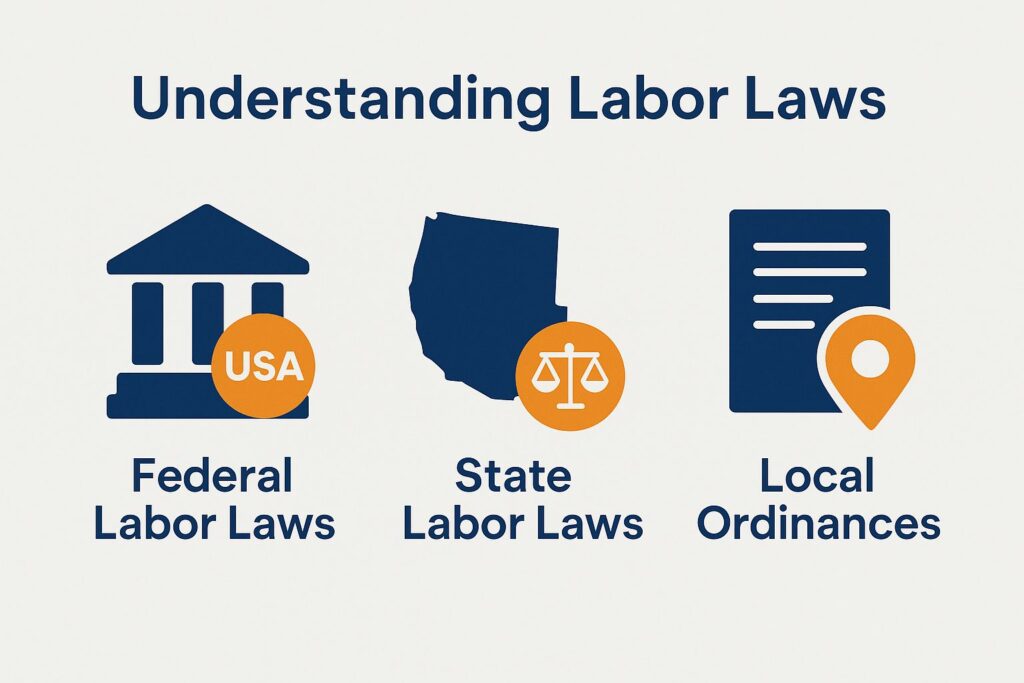
Federal Labor Laws
Federal labor laws, such as the FLSA and OSHA, set minimum standards for workplace safety, wages, overtime pay, and employee protections.
The Fair Labor Standards Act (FLSA) makes sure that workers get at least the federal minimum wage and sets rules for extra pay when working more than 40 hours in a week.
The Occupational Safety and Health Administration (OSHA) establishes safety standards to protect workers from hazardous conditions. For example, businesses must implement safety training and provide necessary protective gear.
For businesses looking to enhance compliance and reduce risk, Professional Employer Organizations (PEOs) can provide essential support (our guide on how PEOs assist with workers’ compensation and compliance explores this in depth).
For more details, visit the U.S. Department of Labor’s website, where you can find detailed resources on following laws and rules, including employment law and compliance risk.
State Labor Laws
Each state has its own set of labor laws that can provide additional protections beyond federal regulations and local ordinances.
For instance, California mandates a minimum wage of $15.50 per hour, while Texas sets its minimum at $7.25. States like New York have specific regulations regarding overtime pay and meal breaks that differ even from federal standards.
It is important for both employees and employers to learn these laws, as they can greatly affect how pay and work hours are set up. For specific details, visit your state labor department’s website to follow local rules.
Local Ordinances
Local ordinances can impose unique workplace regulations that businesses must adhere to in addition to state and federal laws.
San Francisco has a rule that employers must provide paid sick leave. Employees earn one hour of sick leave for every 30 hours they work. Seattle also has strong paid family leave policies that include various family-related absences.
For compliance, businesses should frequently check local government websites, like the San Francisco Office of Labor Standards Enforcement or the Seattle Office of Human Resources, for detailed rules and updates on these laws and local regulations.
Staying informed enables businesses to avoid fines and maintain a positive relationship with employees.
Key Areas of Compliance
To follow the rules, companies need to pay attention to important topics like pay and hours, how workers are categorized, and safe conditions at work.
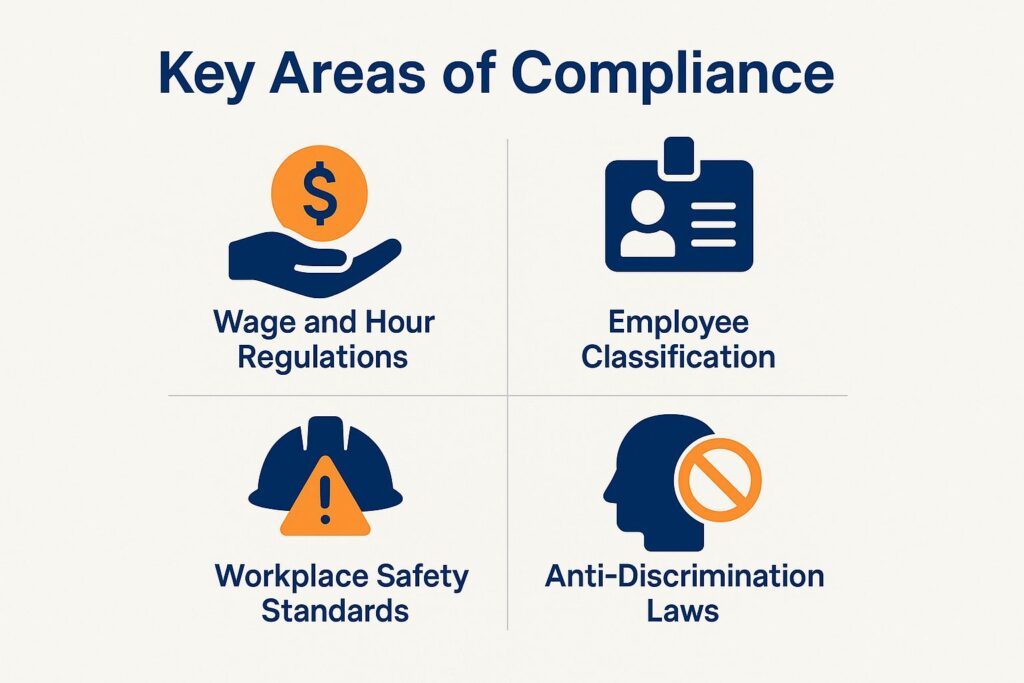
Wage and Hour Regulations
Wage and hour regulations dictate how employers must compensate their employees, including minimum wage and overtime pay criteria.
For instance, if an employee earns $10 per hour, they must receive at least $7.25 per hour as mandated by federal law.
If this employee works over 40 hours in a week, their overtime pay should be calculated at $15 per hour, which is 1.5 times their regular rate.
Employers need to keep accurate records of employee work hours and wages to avoid penalties.
Programs like Gusto or QuickBooks can help you follow regulations and accurately record each employee’s hours and wages, ensuring that payroll is done correctly.
Employee Classification
Correctly identifying employees as exempt or non-exempt is important to prevent legal problems, compliance audits, and follow the law.
Begin by learning about the rules of the Fair Labor Standards Act (FLSA). Key classifications include the salary test, which mandates that exempt employees earn at least $684 per week, and the duties test, which assesses the employee’s primary job responsibilities.
To self-audit, create a checklist:
- Confirm salary thresholds are met;
- Identify primary duties-do they involve management, specialized skills, or administrative tasks?
- Review state-specific regulations for additional compliance requirements.
This thorough review can prevent costly misclassifications, safeguard your business, and avoid penalties.
Workplace Safety Standards
Following the safety rules from OSHA keeps workers safe, reduces legal problems for companies, and helps maintain compliance with safety regulations.
OSHA rules require giving safety training to employees regularly to tell them about risks and safe practices, keeping detailed records of workplace injuries and illnesses, and supplying essential personal protective equipment (PPE).
Companies need to set up a clear system for reporting accidents quickly. Utilizing resources like OSHA’s compliance guidelines or engaging in professional training programs can significantly improve safety measures.
For more information, go to the OSHA website, which provides detailed resources to help organizations follow federal safety rules.
Anti-Discrimination Laws
Anti-discrimination laws stop unfair treatment of workers because of their race, gender, age, and other traits. They help create a workplace where different backgrounds are respected and welcomed.
To create a non-discriminatory workplace, start by familiarizing yourself with key laws like Title VII of the Civil Rights Act, which prohibits discrimination based on race, color, religion, sex, or national origin, and other relevant anti-discrimination policies.
Create a clear policy that explains harassment and discrimination, helping employees feel secure in reporting problems. Teaching managers is important. Think about using LinkedIn Learning for courses on diversity topics.
Create clear procedures for dealing with complaints, including fast investigations and consequences for rule violations, to build a sense of accountability.
Creating a Compliance Checklist
Creating a detailed compliance checklist can help businesses handle legal requirements and reduce risks.
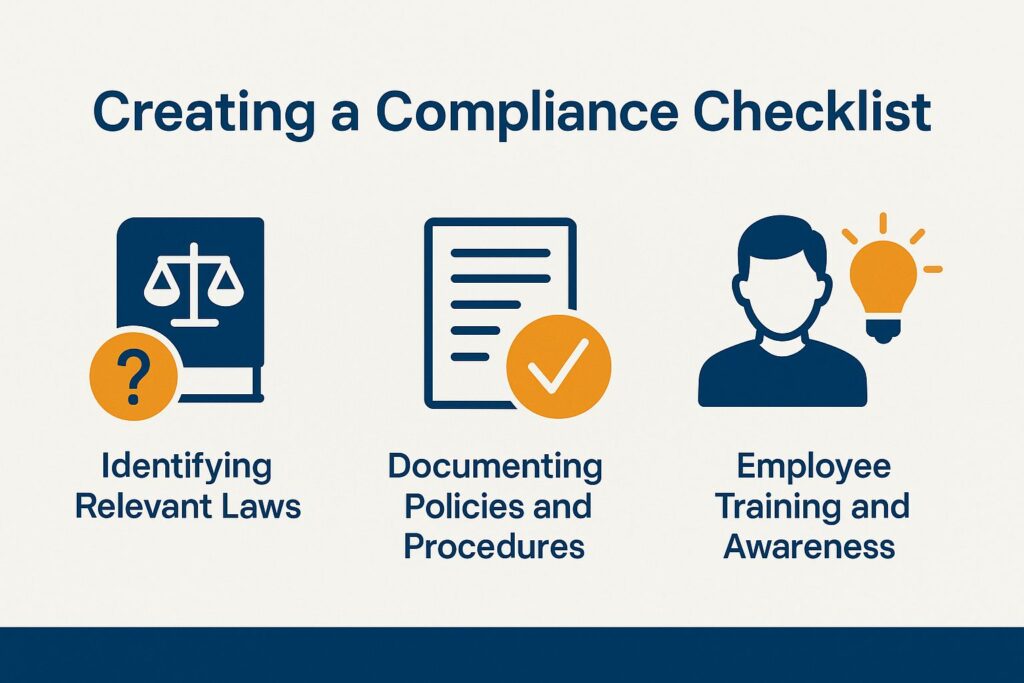
Identifying Relevant Laws
- Begin by identifying all relevant labor laws that apply to your specific business operations and industry.
To understand labor laws, begin by checking federal rules on the Department of Labor’s website. Focus on areas such as wage and hour laws, employee classification, and workplace safety.
Consult state-specific resources, as these can significantly differ. Staying informed about legal changes is important; programs like Compliance.ai can provide automatic notifications and updates on labor regulations.
Talking to legal consultants or local chambers of commerce can give you specific advice for your industry, helping you stay compliant and proactive.
Documenting Policies and Procedures
Writing clear rules and steps is important for creating a workplace that follows the law and adheres to workplace policies.
- Begin by listing all important labor laws to make sure you follow them. This includes rules about overtime, harassment policies, and parental leave. You can use PandaDoc to make and handle these documents quickly and easily.
- When drafting your handbook, consider dividing it into sections, such as ‘Employee Rights’ and ‘Company Expectations,’ for clarity. Set up a yearly review to revise policies based on any changes in laws.
- This proactive approach supports a rule-following workplace and shows you care about your employees’ well-being.
Employee Training and Awareness
Regular employee training and awareness programs are very important for following rules, adhering to employment contracts, and creating a knowledgeable workforce.
- To develop an effective compliance training program, begin with a needs assessment to identify specific regulations relevant to your industry.
- Regularly revise training materials to cover any changes in laws, and schedule sessions twice a year.
- Use e-learning platforms like TalentLMS to make it easier to provide and monitor online courses.
- Add interactive features like quizzes and case studies to increase participation.
- Collect opinions after training to keep improving the program and meet employees’ needs.
Risk Assessment
Carefully examining risks helps businesses find weaknesses in following rules, improve risk management, and fix them early.
Evaluating Current Practices
Begin by evaluating your current HR practices against established compliance benchmarks to identify gaps in legal obligations and record-keeping.
Next, thoroughly review in three steps.
- First, review your employee documentation, including contracts and employee handbooks, ensuring they meet local labor laws and family leave laws. Use a checklist to track necessary updates.
- Second, assess your recruitment methods against diversity and equality compliance metrics and employment eligibility. This might involve analyzing hiring ratios or processes.
- Do an internal survey to see how much employees understand the policies, including whistleblower protection. Aim for at least 80% of employees to respond positively to questions about compliance protocols, indicating readiness and awareness.
Identifying Potential Risks
Identifying potential risks involves analyzing both internal and external factors that could affect compliance, including labor disputes and grievance procedures.
Using tools for employee feedback, like SurveyMonkey, can help understand workplace issues, while compliance software such as Zenefits makes following rules easier, particularly for benefits compliance and contractor compliance.
Developing a risk matrix enables teams to visualize and prioritize potential risks by assessing their likelihood and impact. For example, divide risks into groups such as operational, financial, and reputational, then rate each by how serious they are.
This organized method helps those in charge to distribute resources well and set up needed controls, encouraging an active focus on following rules in the company.
Monitoring and Auditing Compliance
Regular checks and reviews of compliance practices help maintain continuous following of labor laws and rules.
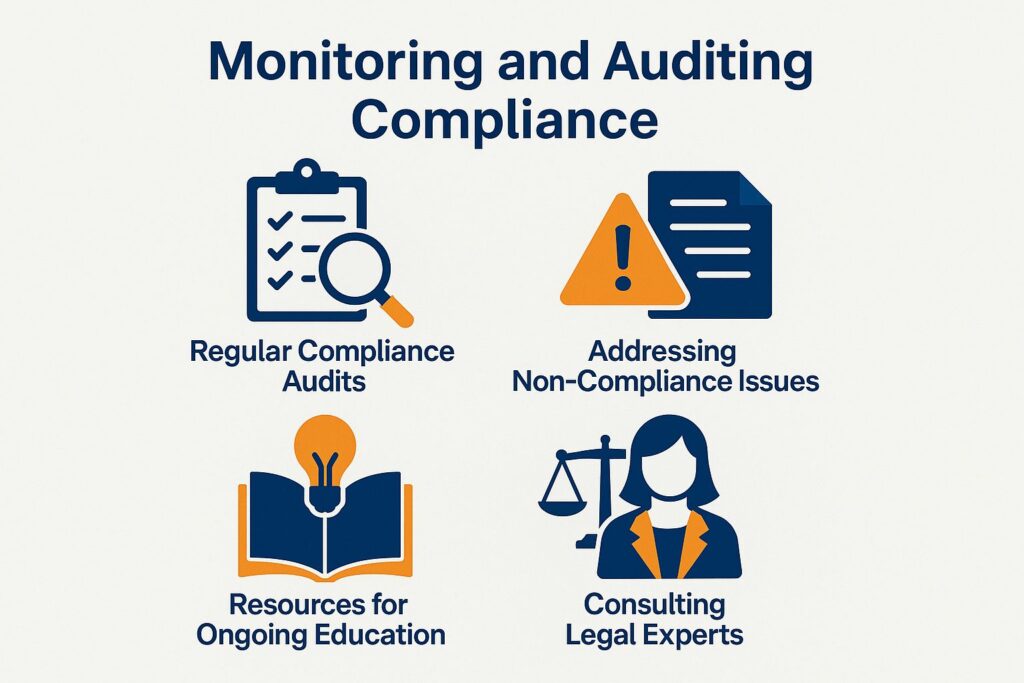
Regular Compliance Audits
Regular compliance audits can find problems early, preventing them from becoming major legal issues.
To cover everything thoroughly, schedule audits quarterly, focusing on different compliance topics each time.
To evaluate your work from a different viewpoint, hire an auditing company such as Baker Tilly or Deloitte. They can provide unbiased feedback.
Key audit areas to evaluate include employment verification and labor compliance:
- Financial records
- Employee training documentation and inspections
- Policy adherence and retaliation policies
Create a checklist to track these components, ensuring nothing is overlooked. For instance, confirm all employees have completed compliance training and that financial reports align with regulatory standards.
This structured approach improves compliance and encourages responsibility within your organization.
Addressing Non-Compliance Issues
When problems with compliance occur, quick action is needed to reduce risks and follow the rules regarding violations and termination procedures.
- Start by documenting the specific non-compliance incidents, noting dates, actions taken, and involved parties.
- Create a plan to fix any issues by quickly starting actions like holding training sessions for employees on compliance rules.
- For preventive strategies, establish regular audits and compliance reviews, utilizing tools like Compliance 360 or RiskWatch to monitor ongoing adherence and workplace investigations.
- Emphasize continual training and updates to policies to keep all personnel informed.
This careful method solves present problems and strengthens your organization against upcoming risks.
Resources for Ongoing Education
Utilizing resources for ongoing education can keep your business informed about the latest labor laws and compliance practices, including state laws and ethics policies.
Use resources such as the Society for Human Resource Management (SHRM) for the latest information and tools made for HR professionals, covering topics like corporate governance and labor relations.
Online platforms such as Coursera offer excellent courses on labor law compliance and workplace regulations, often led by industry experts.
For practical use, think about subscribing to newsletters from legal firms that focus on employment law. These newsletters often share case studies and information about changes in legislation.
Using these resources regularly can help your team better understand and be ready for dealing with difficult compliance requirements.
How PEO Services Can Help
PEO services play a crucial role in helping businesses stay compliant with ever-changing labor laws. These providers monitor federal, state, and local regulations—including wage and hour laws, OSHA requirements, and employee classification rules—so your business doesn’t fall behind. PEOs offer proactive compliance updates, handle payroll tax filings accurately, and provide guidance on tricky issues like overtime, leave policies, and workplace safety. By partnering with a PEO, businesses reduce the risk of costly fines and lawsuits while maintaining a compliant, well-managed HR infrastructure. This allows you to focus on growth while your compliance obligations are expertly managed.
Consulting Legal Experts
Consulting with legal experts can provide you with detailed guidance to keep your compliance plans accurate and up-to-date within your compliance system.
To locate a suitable employment law attorney, consider using platforms like UpCounsel, where you can filter by specialty and read client reviews.
It’s essential to review an attorney’s background and previous cases, ensuring their experience aligns with your business size and industry.
Schedule an initial consultation to discuss your specific concerns, including workplace culture, and assess whether they understand your operational needs.
A good attorney will give clear advice on hiring procedures, employee classifications, and workplace rules, ensuring you are protected against possible legal issues, such as those involving non-exempt employees and overtime rules.
Written by Carol Sanders
Harvard University graduate with a degree in psychology and human resources.
Owner of a PEO consulting firm in Massachusetts and contributing writer for PEO Costs.


